
Visit Our Sponsors |
|
|
|
|
|
|
|
|
|
|
|
|
|
|
|
|
|
|
|
|
|
|
|
|
|
|
|
|
|
|
|
|
|
|
|
|
|
|
|
|
|
|
|
|
|
|
|
|
|
|
|
|
|
|
|
|

Analyst Insight: Different products have different costs and lead times. For example, a customer who requires a custom part from a manufacturer (build to order) will have different service requirements than a customer who sells a commodity (build to stock) part. Thus segmentation of the customers based on their inventory management requirements is necessary. Best-in-Class companies are 1.5 times more likely than all others to be leveraging a statistical method for computing inventory targets.
Seasonal industries can see large swings in demand as well as lead-time variability across demand peaks and lows driven by seasonality. Construction equipment companies are examples of companies that have long-term seasonality and the apparel industry involves short-term seasonality.
-Nari Viswanathan, vice president & principal analyst at Aberdeen Group
Inventory optimization is a highly tangible approach to improve the cash flow of companies. These companies should implement a process that understands demand and lead-time variability across the supply chain and assigns policy at each SKU location. This will globally optimize inventory policies across supply chain tiers, accounting for both demand and supply variability using a stochastic (probabilistic) approach versus a rules-based or deterministic approach that does not fully account for variability.
The reduction in working capital that results in the release of cash can be utilized in several ways. It can be used to pay back debts that companies may have incurred. It can be used to pay interest for notes that companies may have taken. It can also be used for paying dividends to shareholders. However, the most important approach that organizations should take is to invest this unlocked cash flow into growth or profitability initiatives. This is the approach known as leverage in the financial community, namely creating a multiplier in terms of value creation. Supply chain, procurement and manufacturing professionals have a great tool in the form of working capital optimization to create true economic value for their company's shareholders.
The Outlook
The 2008 survey data on working capital optimization (WCO) showed that for 65 percent of respondents WCO was a high priority at the time. In 2010, 83 percent of companies saw WCO as a high priority. The top driver compelling companies to focus on WCO in 2008 and in 2010 was the pressure by financial stakeholders to improve working capital metrics (reported by 66 percent in 2008 and 60 percent in 2010). In 2010, however, the shortage of working capital to support basic operations is the number two pressure compared to inventory- and business-expansion-related pressures that were predominant in 2008. This trend is expected to continue in 2011 with working capital optimization remaining a top priority for CFOs and chief supply chain officers alike.
RELATED CONTENT
RELATED VIDEOS
Timely, incisive articles delivered directly to your inbox.







